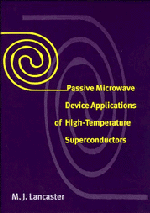Book contents
- Frontmatter
- Contents
- Preface
- Acknowledgements
- 1 Superconductivity at microwave frequencies
- 2 Superconducting transmission lines
- 3 Superconducting cavity resonators
- 4 Microwave measurements
- 5 Superconducting filters
- 6 Superconducting delay lines
- 7 Superconducting antennas
- 8 Signal processing systems
- Appendix 1 The surface impedance of HTS materials
- Appendix 2 Substrates for superconductors
- Appendix 3 Some useful relations
- Index
Appendix 2 - Substrates for superconductors
Published online by Cambridge University Press: 14 September 2009
- Frontmatter
- Contents
- Preface
- Acknowledgements
- 1 Superconductivity at microwave frequencies
- 2 Superconducting transmission lines
- 3 Superconducting cavity resonators
- 4 Microwave measurements
- 5 Superconducting filters
- 6 Superconducting delay lines
- 7 Superconducting antennas
- 8 Signal processing systems
- Appendix 1 The surface impedance of HTS materials
- Appendix 2 Substrates for superconductors
- Appendix 3 Some useful relations
- Index
Summary
Substrate requirements
Superconducting films have to be grown on some sort of substrate which must be inert, compatible with both the growth of a good quality film and also have appropriate microwave properties for application purposes. From the microwave point of view, a high dielectric constant of well-known value is good for miniaturising components, as discussed in chapter 5. However, for higher frequencies this miniaturisation may be a problem in that the size of the circuit may be reduced considerably and the size reduction may make it difficult to produce the device. The design of devices is simplified if the dielectric constant is isotropic in the plane of the film and has a low dispersion for wide band devices, although compensation can be built into the device design if the parameters are sufficiently well characterised. It is also more convenient if the dielectric constant does not change much with temperature, improving the temperature stability of the final application. Whatever the dielectric constant, it must be reproducible and not change appreciably from batch to batch. For many of the devices discussed in this text a low dielectric loss tangent is of fundamental importance, especially on high-Q filters or resonators or long delay lines. If the loss tangent is not low enough, then the advantage of using a superconductor can be negated.
- Type
- Chapter
- Information
- Publisher: Cambridge University PressPrint publication year: 1997



